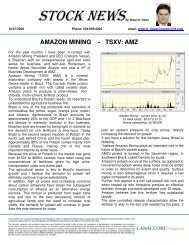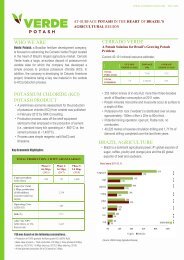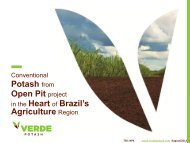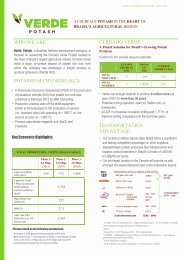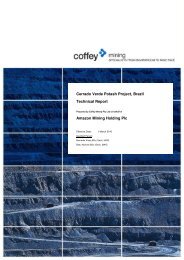NI 43-101 Preliminary Economic Assessment - Verde Potash
NI 43-101 Preliminary Economic Assessment - Verde Potash
NI 43-101 Preliminary Economic Assessment - Verde Potash
Create successful ePaper yourself
Turn your PDF publications into a flip-book with our unique Google optimized e-Paper software.
<strong>Verde</strong> <strong>Potash</strong> Plc 12-13<br />
Cerrado <strong>Verde</strong> Project<br />
<strong>NI</strong> <strong>43</strong>-<strong>101</strong> <strong>Preliminary</strong> <strong>Economic</strong> <strong>Assessment</strong><br />
For the mineralization in question the IDW method was used with the search ellipse defined by<br />
the axis of the geostatistical analysis. Was used the ellipse divided into four sectors. The search<br />
radius were determined by semi variogram models. The parameters of the search ellipse radius<br />
are presented in Table 12.2.7.1.<br />
Table 12.2.7.1: Search Ellipse Parameters to Interpolate the Grades by the IDW And<br />
Kriging Methods of Target 6<br />
Radius Azimuth Factor Dip Factor Thickness Factor Min. Points by Sector Min. Count Fields<br />
0.6667 324 222 30 3 2<br />
1 324 222 30 2 2<br />
2 324 222 30 2 1<br />
3 324 222 30 1 1<br />
4 324 222 30 1 1<br />
100 324 222 30 1 1<br />
After comparing the results of Kriging interpolation and IDW2 methods for target Target 6<br />
(Table 12.2.9.1), it was decided to use IDW2 as the main interpolation method for the other<br />
bodies. Search ellipse parameters used to interpolate the grades for the other targets are shown<br />
in Table 12.2.7.2.<br />
Table 12.2.7.2: Ellipse Search Parameters Used to Interpolate the Grades by the IDW<br />
Method for Target 4, 7, 10 and 11<br />
Radius Azimuth Factor Dip Factor Thickness Factor Min. Points by Sector Min. Count Fields<br />
0.6667 150 100 15 3 2<br />
1 150 100 15 2 2<br />
2 150 100 15 2 2<br />
3 150 100 15 1 1<br />
4 150 100 15 1 1<br />
100 150 100 15 1 1<br />
The blocks for each zone of the mineralization were interpolated using only composite samples<br />
belonging to the corresponding part of the body. During the interpolation process was used the<br />
discretization process for each block, using a factor 4 for the X and Y axis, and a factor 2 for Z<br />
axis. This makes it possible to evaluate each block in four positions and assign to the center of<br />
the block the average of these values. This increases the accuracy of estimating the grade of<br />
each block.<br />
The constraints presented by each ellipse search sector were: the maximum number of points in<br />
the sector - 5 and the minimum point total for the interpolation, which varied depending on the<br />
size of the ellipse (from 3 to 1). Thus, the maximum total number of samples involved in the<br />
interpolation was 20.<br />
In the resources classification was used some parameters, as: the ellipse search radius (based on<br />
geostatistical studies), the kriging variance and the minimum drillhole number used in the block<br />
interpolation. In the resources classification of Target 6, inferred and indicated resources have<br />
been allocated. For the indicated resource was allocated blocks interpolated by the first and<br />
second search ellipses, with kriging variance less than 2, drillhole grid in the area about 200 by<br />
200 m, and used in the samples interpolation at least two different drillholes.<br />
SRK Consulting (U.S.), Inc. September 16, 2011<br />
Cerrado <strong>Verde</strong>_<strong>NI</strong> <strong>43</strong>-<strong>101</strong> PEA_3<strong>43</strong>500.020_007_KG




